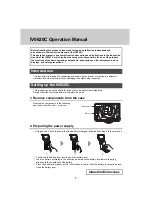
Lake Shore Model 475 Gaussmeter User’s Manual
Introduction
1-3
1.1.2
Measurement Features
The Model 475 offers a variety of features, implemented in the instrument firmware, to enhance usability and
convenience of the gaussmeter.
Auto Range:
In addition to manual range selection, the instrument will automatically choose an appropriate range for
the measured field. Auto range works in DC and AC measurement modes.
Auto Probe Zero:
Allows the user to zero all ranges for the selected measurement mode with the push of a key.
Display Units:
Field magnitude can be displayed in units of G, T, Oe, and A/m.
Max/Min Hold:
The instrument stores the fully processed maximum and minimum DC or RMS field value. This differs
from the faster peak capture feature that operates on broadband, unprocessed field reading information.
Relative Reading:
Relative feature calculates the difference between a live reading and the relative setpoint to highlight
deviation from a known field point. This feature can be used in DC, RMS, or Peak measurement mode.
Instrument Calibration:
Lake Shore recommends an annual recalibration schedule for all precision gaussmeters.
Recalibrations are always available from the factory but the Model 475 allows users to field calibrate the instrument if
necessary. Recalibration requires a working computer interface and precision low resistance standards of known value.
1.1.3
Probe Support
The Model 475 has several capabilities that permit the best possible measurements with Lake Shore probes. These
firmware-based features work in tandem with the calibration and programming of the probe to ensure accurate,
repeatable measurements and ease of setup. Many of the features require probe characteristics that are stored in non-
volatile memory located in the probe connector during calibration.
Probe Field Compensation:
The Hall-effect devices used in gaussmeter probes produce a near linear response in the
presence of magnetic field. The small non-linearities present in each individual device can be measured and subtracted
from the field reading. Model 475 probes are calibrated in this way to provide the most accurate DC readings.
Probe Temperature Compensation:
Hall-effect devices show a slight change in sensitivity and offset with temperature.
A probes temperature effects can be measured and subtracted out of field readings. A temperature sensor, installed in the
probe tip of Model 475 probes, relays real time temperature to the gaussmeter so that it can perform compensation.
Although temperature effects contribute only a small fraction of the overall probe measurement accuracy, temperature
compensation will often improve measurement and control stability.
Probe Temperature Display:
When using a probe that includes a temperature sensor, the gaussmeter can display the
temperature of the probe in °C along with a field reading.
Frequency Display:
When operating in RMS mode, the gaussmeter can display the frequency of the measured AC field
along with a field reading.
Probe Information:
The gaussmeter reads the probe information on power up or any time the probe is changed to allow
hot swapping of probes. Critical probe information can be viewed on the front panel and read over computer interface to
ensure proper system configuration.
Extension Cables:
The complex nature of Hall-effect measurements makes it necessary to match extension cables to the
probe when longer cables are necessary. Keeping probes and their extensions from getting mixed up can become a
problem when more than one probe is in use. The Model 475 alleviates some of the difficulty by allowing users to match
probes to extensions in the field. Stored information can be viewed on the front panel and read over computer interface
to ensure proper mating.














































